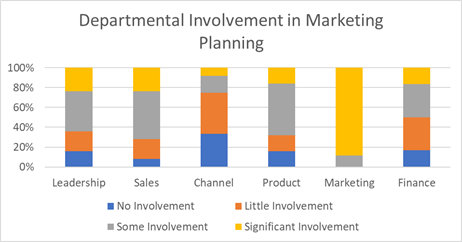 A strong marketing plan isn’t just about marketing. It needs to combine other planning processes from other departments that are involved with marketing in any way, shape or form. And that’s a lot of departments, when leadership, sales, channel, product and finance all play such an integral part in the role of marketing.
A strong marketing plan isn’t just about marketing. It needs to combine other planning processes from other departments that are involved with marketing in any way, shape or form. And that’s a lot of departments, when leadership, sales, channel, product and finance all play such an integral part in the role of marketing.
We have referenced the below chart before, but we have not given it a proper discussion. A recent study from SiriusDecisions found that very few departments are significantly involved in the marketing plan outside of the marketing department in any way. Of all the departments mentioned above, sales plays the most significant role in the marketing plan, with 23% of companies interviewed playing a significant role. But, on average, across all non-marketing departments, the rate of significant involvement is just 18%.

Source: 2019 SiriusDecisions Marketing Planning Maturity Study
The Implications of No Collaboration
So, why is this rate so low, and more importantly, what kind of impact does this have on your marketing plan? For most companies, it means that they are experiencing departmental silos, because as we’ve seen, other departments aren’t on the same page when it comes to the marketing plan - and this has its implications.
When other departments aren’t involved in the marketing plan, there’s a breakdown in communication and collaboration. And if other departments aren’t working with the marketing plan, it means they’re working toward different goals and objectives. For your marketing plan, that means important information is missed, and progress becomes much more difficult to track. Leads are not produced to specifications agreed to by lead recipients. Leads are not worked in a timely manner. Themes from marketing are not aligned with sales. Creative assets get produced but not used. The list goes on.
The Answer to Breaking Down Departmental Silos
We know that a lack of collaboration is the problem, but how do you go about changing this? The answer to this is a collaborative planning environment, which, as you would expect, integrates other departments into the marketing plan – here’s how it works, along with the advantages it can bring to your marketing plan:
- Important decisions are more likely to be made, because departments are a part of the process to reach a solution in the marketing plan. This is important because when departments aren’t involved in the plan, they’re more likely to remain as critics outside of the process.
- Having other departments involved in the marketing plan is going to follow in the general interests of the company. It means that more alternatives will be put forward and considered.
- The chances of a plan being successfully implemented are going to increase, because departments are involved in the plan, wanting to make sure it goes ahead because they have a stake in the outcome. This goes away from departments having their own goals and objectives that compete with the marketing plan.
- Closer alignment amongst departments will create a closer understanding, and with this comes a culture of collaboration that benefits the company in ways that go beyond a marketing plan.
The role of a collaborative planning environment is to enable the integration of different departments into the marketing plan and to delegate responsibility to each of the departments. By doing so, you transform the way that planning is done and how other departments interact with the marketing plan.
Are you ready to try this out for yourself? Hive9 gives you the platform to tear down silos by providing one place for your team and other departments to collaborate. Request a demo and see the changes to your marketing plan.




